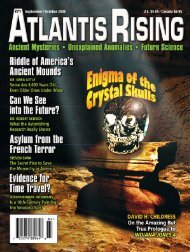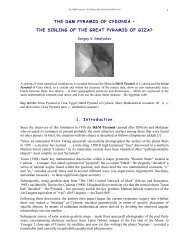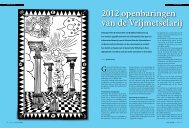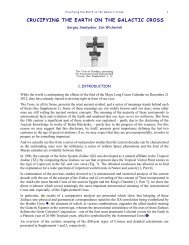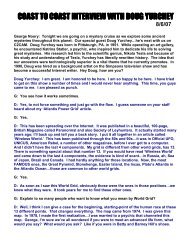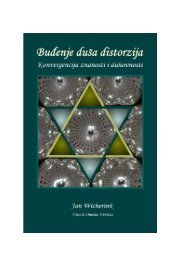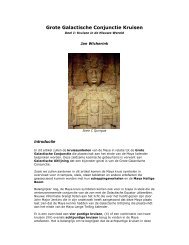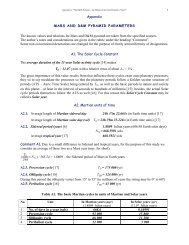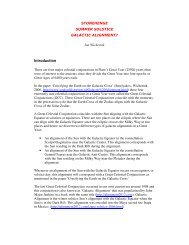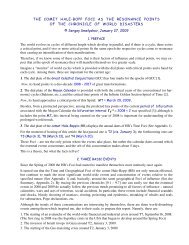Great Celestial Conjunction Crosses - Souls of Distortion
Great Celestial Conjunction Crosses - Souls of Distortion
Great Celestial Conjunction Crosses - Souls of Distortion
Create successful ePaper yourself
Turn your PDF publications into a flip-book with our unique Google optimized e-Paper software.
At the bottom on the river four 8 pointed crosses are depicted. I suggest<br />
that they represent the four <strong>Great</strong> <strong>Celestial</strong> <strong>Conjunction</strong>s that appear in a<br />
<strong>Great</strong> Year.<br />
The Sumerian epic <strong>of</strong> Gilgamesh is believed to be an allegory <strong>of</strong> the precessing<br />
<strong>of</strong> the Sun along the zodiac signs in the precession cycle. The epic recounts<br />
Gilgamesh slaying <strong>of</strong> the Heavenly Bull (Taurus). The killing <strong>of</strong> the bull enraged<br />
Ishtar who had complained to the god Anu and asked for the Bull <strong>of</strong> the<br />
Heaven when Gilgamesh refused to marry her. After Gilgamesh and his friend<br />
Enkidu killed the bull they <strong>of</strong>fered its heart to Utu/Shamash (the Sun).<br />
This epic is believed to recount the transition <strong>of</strong> equinox sun from the Age <strong>of</strong><br />
Taurus into the Age <strong>of</strong> Aries. Gilgamesh after his victory over the Bull <strong>of</strong> the<br />
Heavens became the first Sumerian shepherd King (Aries is the sign <strong>of</strong> the<br />
sheep). Ishtar in the epic is associated with the vernal equinox that determines<br />
the current Age in the precession cycle. This is why we still celebrate Easter<br />
(Ishtar) around the vernal equinox.<br />
In the epic <strong>of</strong> Gilgamesh we also find a recount <strong>of</strong> the <strong>Great</strong> Flood. A retelling <strong>of</strong><br />
the Sumerian version <strong>of</strong> the Deluge is found in the Old Testament and is known<br />
as the biblical story <strong>of</strong> Noah’s Ark. The epic <strong>of</strong> Gilgamesh is recorded in twelve<br />
clay tablets (signs <strong>of</strong> the zodiac) within a cyclic nature that is to say that the<br />
beginning lines are quoted in the 11 th tablet. In the 12 th tablet Gilgamesh enters<br />
into the Underworld. In another epic Ishtar enters the underworld through the<br />
seven gates <strong>of</strong>fering one piece <strong>of</strong> clothing for each gate that she passes. By the<br />
time she has entered into the underworld she stands naked. This tale may relate<br />
to the spiritual evolution <strong>of</strong> mankind and the spiritual development through the<br />
seven planes <strong>of</strong> consciousness corresponding with the 7 chakras to finally meet<br />
the naked Higher Self at the end <strong>of</strong> his spiritual journey.<br />
Gilgamesh and Enkidu fighting a lion (Leo) and a bull<br />
(Taurus). Notice the 8 rays <strong>of</strong> the Sun Utu/Shamash!<br />
Cylinder seal from Ur.<br />
Did the Sumerians understand that there is a fixed cross in the sky?<br />
The Ishtar Gate was the 8 th gate to Babylon and its walls contained bulls and<br />
dragons (serpents) that were depicted interchangeably. Through the gate ran<br />
the Processional Way into the city to the temple <strong>of</strong> Marduk. At a right angle to the<br />
walls <strong>of</strong> the gate we find a wall adorned with lions! The Ishtar Gate is symbolizing<br />
two <strong>of</strong> the four Cherubim signs <strong>of</strong> the zodiac at right angles exactly as they<br />
appear on the zodiac and may therefore represent the fixed cross or the Galactic<br />
Cross.



